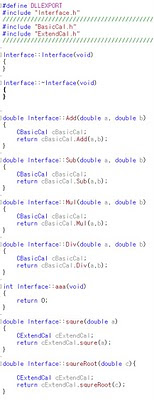Created Date : 2011.08.
Language : C++ /MFC
Tool : Visual Studio C++ 2008
Library & Utilized : -
Reference : -
Etc. : -
*Make DLL
1. create project3. Add functions
Now, we will process theses functions in the new class.
Because we donn't want to exposure source code of function.
So we made interface class for dll distribution.
4. Create Class #1
This is class for basic calculation. (+,-,/,*)
5. Create Class #2
This is class for squre, sqrt calculation.
6. Use Class #1, Class #2 in the Dll interface class.
7. Compile and Use dll, lib, h at other program.
*Use DLL
1. Make project
2. Copy lib, dll, h into new project folder.
3. Write dll file name into Additional library
4. Now, let's program using dll
Source code <here>
In the source code, Making DLL and Using DLL projects are included.
And also there is a document but it is written by korean but it is same content with I posted.
Thank you.
Plz give me your valuable opnion.
And I want to your comment about my broken english.














































